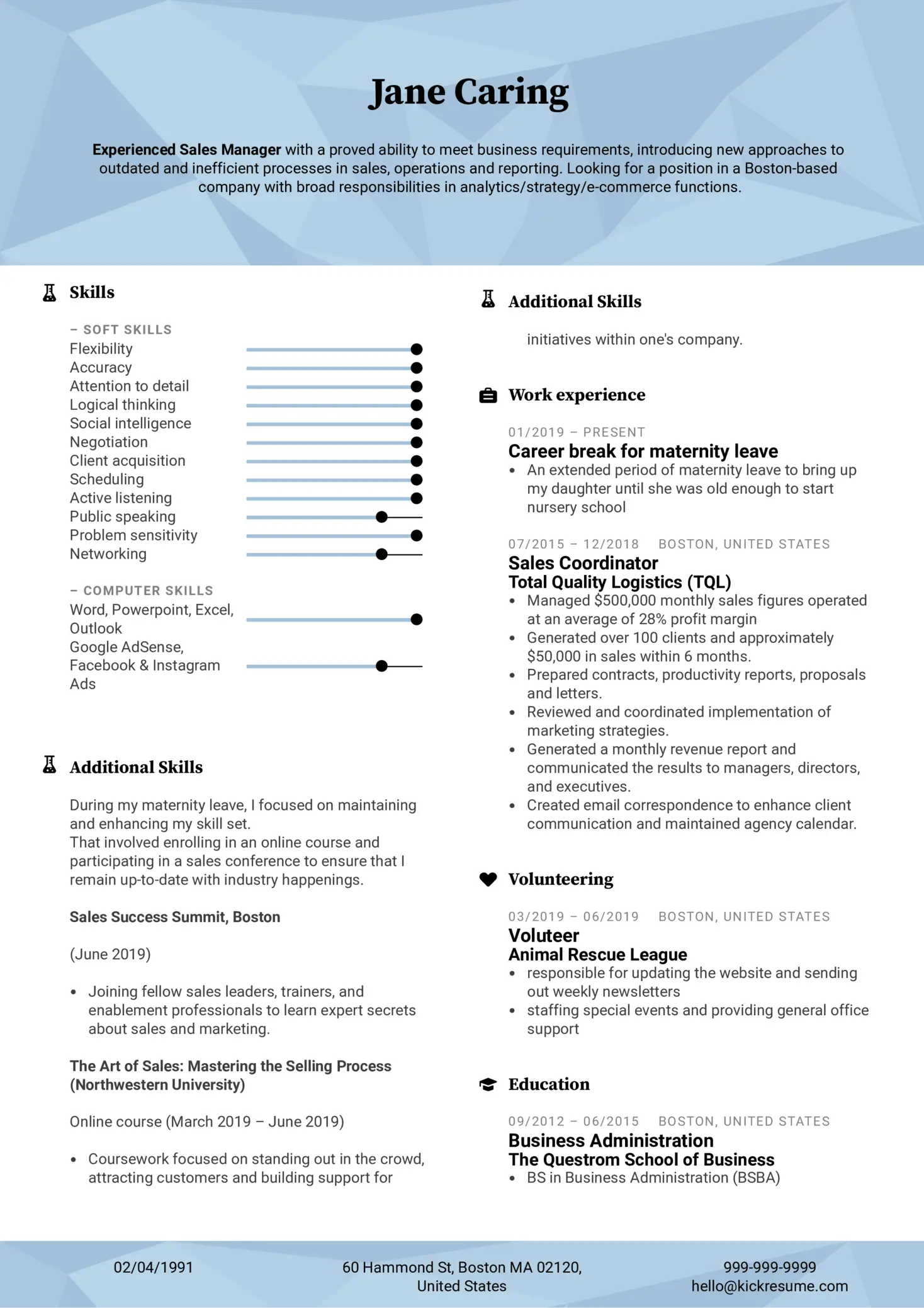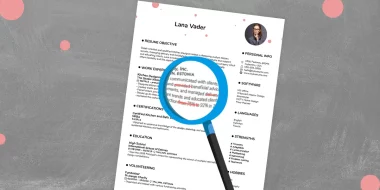Returning back to work — or even looking for a new job — may be a real challenge after a maternity leave. The best thing to do is to prepare and know how to update your resume after maternity leave.
Because once you leave for a maternity leave, you’ll be confronted with a gap in your resume. And future prospective employers will be curious to know why you didn't work for weeks or even months.
There’s nothing to fear, though. Your skillset hasn’t shrunk. In fact, it's expanded.
Mothers have to fill in plenty of roles — they're managers, psychologists, doctors, and storytellers. All at the same time.
To help you burnish this experience and get your career back on track, here's a short guide on how to update your resume after maternity leave and explain the gap in your resume.
Resume example included, of course.
What do recruiters think about maternity leave?
Most recruiters will understand the gap in your resume. After all, this won't be their first time reading a resume of a recent mother who's applying for a full-time job.
It's good to remember though that it's illegal for potential employers to ask questions about your personal life.
At the same time, leaving an unexplained career gap in your resume isn't a good idea either.
To admit to an HR manager that your recent resume gap was due to maternity leave has its plus sides but also its downfalls.
While some recruiters may l assume that — thanks to colic and midnight feedings — you may not be able to deliver the best performance at work right now, others may see your recent birth as a good thing.
If nothing else, they may assume that you won't be taking another maternity leave anytime soon.
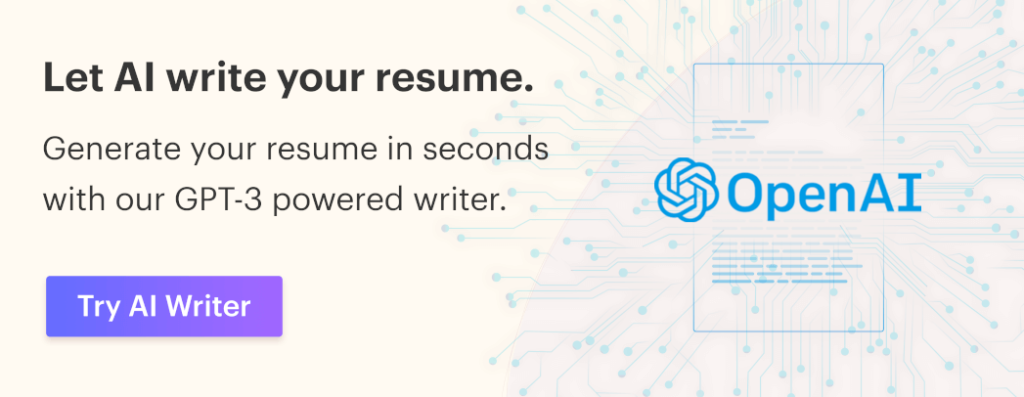
Things to avoid when addressing your maternity leave
One thing that you should surely avoid is to hope that the potential employer won’t notice the gap or that you won't have to include it in your resume at all.
The best approach is to address the maternity leave head-on in your “Work Experience” section.
And even though the mention of maternity leave concerns your life outside of work, it's still advised to remain professional when talking about it.
Resist the temptation to use euphemisms or joke about it.
Naming your months (or even years) as "Domestic Executive" is just a little cringe on top of it being misleading.
To put it simply, being honest and explaining the CV gap openly (but still in professional terms) is the way to go.
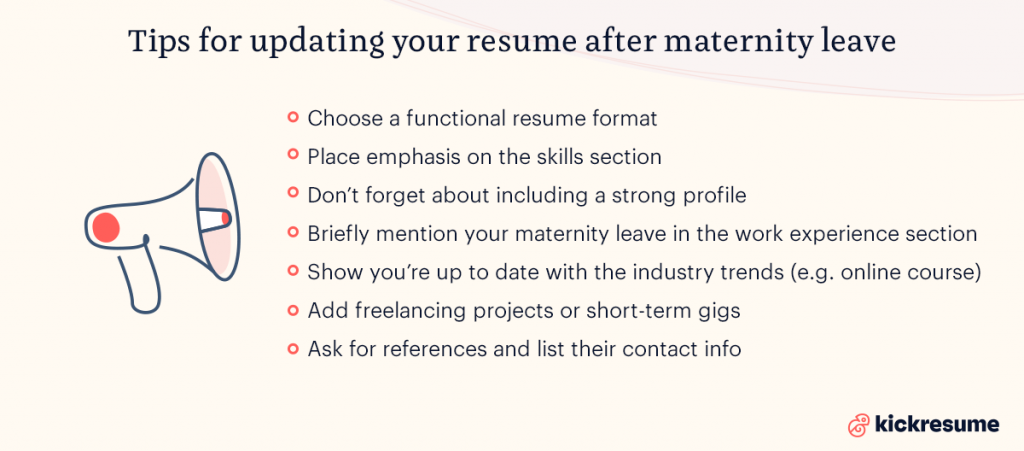
How to update your resume after maternity leave?
First, choose a resume format that will highlight the most important details about your professional qualities and your personality traits.
This type of resume is called a functional resume. This CV format lets you introduce your skills first — which is precisely something that you want to do after maternity leave.
Here's a list of resume sections to include in your updated CV:
- Professional summary
- Skills
- Additional skills
- Work experience
- Education
- Volunteering
- References
- Optional (Awards, Accomplishments, Courses, etc.)
1. Skills
The next step of updating your resume after maternity leave is to add newly gained abilities into your pre-existing list of professional “Skills” that you had listed on your old resume.
However, don't add just whatever skill.
Remember to include those skills that are relevant to the job you're hoping to land and that reflect your experience in your field.
If you don't know what we have in mind, take a look at the example of the skills resume section below:
Skills
2. Additional/relevant skills section
Employers still often see large employment gaps as a red flag. So, you need to show you stayed on top of the most recent developments in your field.
If relevant, show them that you're up to date with the trends in the field by filling in sections such as “Relevant skills” or “Additional skills.”
Here's an example of how you can do it:
Additional Skills
A description like this will enable you to show that you used your time away from work for self-development, and will also boost your value as an employee.
Your potential employer will probably appreciate that you're still committed to your career and can contribute to the company's success.
However, in no way this means that you should be pressured into focusing on work during your maternity leave. It's absolutely more than enough to focus on one thing at a time.
And thankfully, many modern workplaces are finally starting to acknowledge this as well.
3. Work experience
After all of the skills are filled in, the following thing to do is to fill in the “Work Experience.”
It's here where you can briefly mention that your career gap was due to maternity leave.
This way, your maternity leave won't be the first thing that the recruiter will notice, but it also won't be ignored completely.
In this section, make sure to put emphasis on the work you did before you took time off.
Talk about it — ideally in bullet points — as if it were yesterday. Focus on the details of the projects you worked on.
Recall your accomplishments and the projects you're proud of from that period of your life. Time doesn’t devalue those experiences and skills you learned working on them.
See the sample below for inspiration:
Work Experience
4. Education
The importance of having a solid education or training doesn't go away just because you took a couple of months (or years) off.
That's why in your updated resume, you should highlight your academic accomplishments and again draw some attention to them — even if you've finished your studies years ago.
Have you graduated with excellent grades or an award? Perfect! Make sure you mention it.
On the other hand, remember that skills and work experience still carry more importance, especially if you're a somewhat seasoned professional.
Therefore, make sure you place your education lower than more important sections.
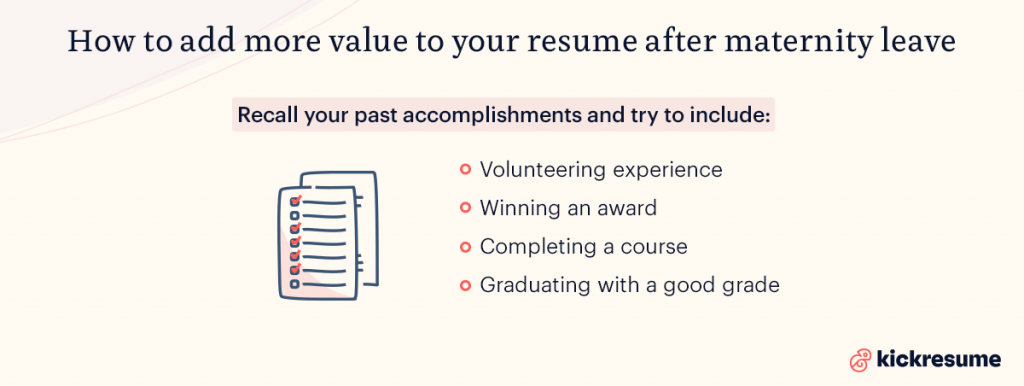
5. Volunteer activities
Have you participated in non-professional activities while you were on your maternity leave?
Maybe you and your children visited a nearby shelter and walked some dogs. Or you helped out during a community event in your neighborhood.
If yes, let these activities speak of your determination and a spirit of goodwill.
Mention any relevant community service or voluntary work that you engaged in during (or before) your time away from work in a separate “Volunteering” section.
Try to draw a conclusion on what you gained in terms of professional insights and technical skills from these volunteer activities.
Employers will like seeing you're an active person using their skills and free time in a useful way:
Volunteering
6. Optional
Now think — “What else have I done that makes my professional journey different from everyone else?”
Have you completed any courses? Won an award?
Put it in your resume!
In other words, demonstrate that you're an active person with drive and many interests in any way you can.
Finally, any freelancing projects or short-term gigs also work as great resume enhancers.
7. References
Finally, you can use the power of networking — even during or after the parental leave.
Stay in touch with others working in your professional field. And think of anyone that could help you find a job and provide a better starting point in your job search.
Call up your former colleagues, send out emails asking for references and recommendations and use your LinkedIn to make new connections (by the way, your LinkedIn profile deserves a makeover, too).
Hiring managers will appreciate recommendations from trusted authorities — be it your former employers or seasoned field professionals:
References
Sample of a resume updated after maternity leave
One image can speak more than a thousand words. See all of the above points summarized in the resume sample below.
This is how you do it.
Jane has correctly:
- chose a functional resume format
- briefly mentioned maternity leave in the “Work experience” section
- included industry-relevant skills gained during maternity leave
- added volunteering experience
- included a reference
On top of having a good selection and order of resume sections, Jane also selected a resume template that catches the eye of the recruiter with its nice design.
Her resume is also well-organized and airy as she doesn't waste words and leaves enough space between various sections.
Final tips
As you can see, maternity leave resume gaps shouldn't make you feel less skilled or less professional. There are very elegant ways to deal with it on your resume and turn it into an advantage.
All in all, you just need to make it clear that you’ve remained committed to your career goals and have the skills and expertise necessary to play a vital role in the company.
And if you get questions about your career gap during your interview, keep it brief and to the point. Don't lie about it or avoid the question. Rather, just quickly move on to other profession-related topics.
And remember — in uncomfortable situations like this, being confident and self-assured can always get you far.
Best of luck to you!
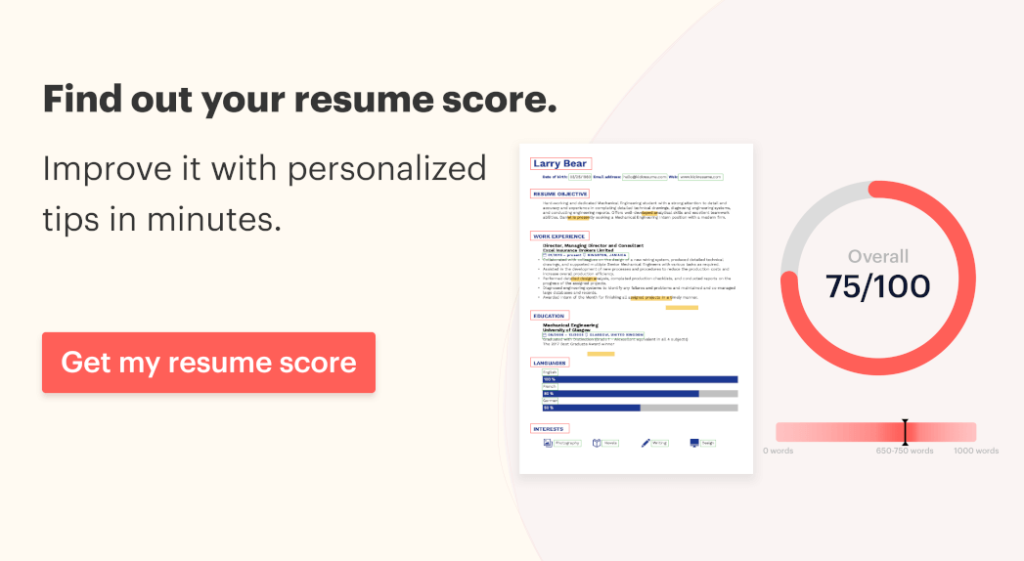
This article was recently updated. The original article was written by Jakub Kaprál in 2019.


